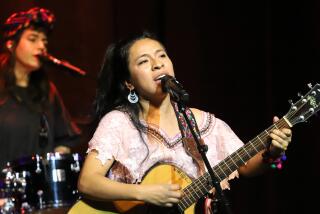A Chilean pop song meets Andean architecture, and the result in Gepe’s music video is hypnotic
- Share via
Sometimes a music video comes along that features all the right things: a catchy Latin American pop tune, scenes of revelrous cannibalism and psychedelic Andean architecture.
“Hambre,” a 2015 single by Chilean pop star Gepe, with a guest spot by Peruvian songstress Wendy Sulca, magically checks off all three.
Filmed by London-based video director Ian Pons Jewell — who has also made videos for Long Beach rapper Vince Staples, among others — the video is set in one of the vivid structures designed by Bolivian architect Freddy Mamani, whose wildly patterned designs have sprouted around La Paz and beyond over the last decade.
These postmodern structures are the sort of thing that grab you buy the eyeballs and don’t let go — featuring an array of geometric patterns, shining glass facades, pre-Columbian motifs and a color palette inspired by indigenous artistic traditions. Last year, a reporter for the Guardian wrote that walking into one of Mamani’s buildings was “like coming out of a rabbit hole into an electric Bolivian wonderland.”
Collectively, his buildings represent a uniquely Andean style of building. The visual jolt, Mamani told the Guardian, is an attempt to create something dynamic against the austere Andean plain, a landscape whose color palette ranges from brown to brown. It’s also a nod to his country’s cultural history.

In a statement about his work released ahead of an exhibition staged in La Paz, the architect said that he was interested in constructing buildings that reflect a unique Bolivian identity.
“It’s something that has developed out of two principal areas: highlighting the Andean iconography of Tiwanaku [the famous Bolivian pre-Columbian ruins site] as a source of inspiration, and fusing the colors and designs of indigenous Andean textiles into architecture.”
Gepe’s music video — a mordant tale of desire and immoral feasting — takes full advantage of Mamani’s lovingly crafted interiors, which are designed by the architect down to the last bright stripe and glowing LED.
The singer, whose music is influenced by Andean folk and other traditions, has made other videos that evoke the region, such as the 2013 song “Bomba Chaya,” shot in Peru. Likewise, Jewell had done other work in Bolivia. Both settled on Mamani’s building as the ideal place for their surreal video — for a song whose refrain is beyond catchy. (I’ve been singing it to myself all afternoon.)
Latin pop and Andean architecture? It’s absolutely hypnotic.
To see more pictures of the work of Freddy Mamani, see Plataforma Arquitectura, which has an extensive photo essay by photographer Alfredo Zeballos.
Find me on Twitter @cmonstah. Find Gepe @gepegepegepe.
More to Read
The biggest entertainment stories
Get our big stories about Hollywood, film, television, music, arts, culture and more right in your inbox as soon as they publish.
You may occasionally receive promotional content from the Los Angeles Times.











